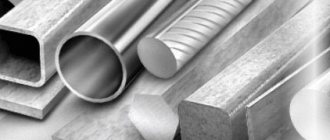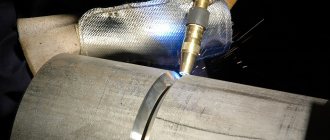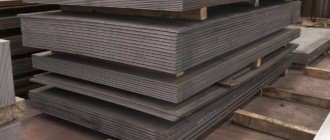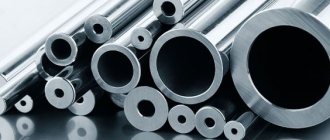Mechanical properties of materials
Mechanical properties characterize the ability of materials to resist external forces. The main mechanical properties include strength, hardness, impact strength, elasticity, ductility, brittleness, etc.
Strength is the ability of a material to resist the destructive effects of external forces.
Hardness is the ability of a material to resist the penetration of another, harder body into it under load.
Viscosity is the property of a material to resist destruction under dynamic loads.
Elasticity is the property of materials to restore their size and shape after the load is removed.
Plasticity is the ability of materials to change their size and shape under the influence of external forces without collapsing.
Fragility is the property of materials to collapse under the influence of external forces without residual deformation.
In static tensile tests, values characterizing the strength, ductility and elasticity of the material are determined. Tests are carried out on cylindrical (or flat) samples with a certain ratio between length l0 and diameter d0. The sample is stretched under the action of the applied force P (Fig. 1, a) until destruction. An external load causes stress and deformation in the sample. Stress σ is the ratio of force P to cross-sectional area F0, MPa:
σ = P/F0,
Deformation characterizes the change in sample dimensions under load, %:
ε = [(l1-l0)/l0] 100,
where l1 is the length of the stretched sample.
Deformation can be elastic (disappearing after the load is removed) or plastic (remaining after the load is removed).
During testing, a tensile diagram is drawn, which represents the dependence of stress on deformation. In Fig. 1 shows such a diagram for low-carbon steel. After testing, the following characteristics of mechanical properties are determined.
The elastic limit σу is the maximum stress at which plastic deformation does not occur in the sample.
The yield strength σт is the stress corresponding to the yield area on the tensile diagram (Fig. 1). If there is no yield plateau on the diagram (which is observed for brittle materials), then the conditional yield strength σ0.2 is determined - the stress causing plastic deformation equal to 0.2%. Ultimate strength (or temporary resistance) σв is the stress corresponding to the maximum load that the sample can withstand during testing.
Relative elongation after rupture δ is the ratio of the increment in length of the sample during tension to the initial length l0, %:
δ = [(lk-l0)/l0] 100,
where lк is the length of the sample after rupture.
Rice. 1. Static tensile tests: a – test diagram;
b – tension diagram
Relative narrowing after rupture ψ is the decrease in the cross-sectional area of the sample, related to the initial cross-section of the sample, %:
ψ = [(F0-Fk)/F0] 100,
where Fк is the cross-sectional area of the sample at the fracture site. Relative elongation and relative contraction characterize the plasticity of the material.
The hardness of metals is measured by pressing a hard tip of various shapes into the test sample.
The Brinell method is based on pressing a hardened steel ball into the metal surface under a certain load. After the load is removed, an imprint remains in the sample. The Brinell hardness number HB is determined by the ratio of the load acting on the ball to the surface area of the resulting print.
The Rockwell method is based on pressing a hardened steel ball with a diameter of 1.588 mm (scale B) or a diamond cone with an apex angle of 120° (scales A and C) into the test sample. Indentation is carried out under the action of two loads - preliminary equal to 100 N and final equal to 600, 1000. 1500 N for scales A, B and C, respectively. The Rockwell hardness number HRA, HRB and HRC is determined by the difference in indentation depths.
The Vickers method uses indentation of a diamond tetrahedral pyramid with an apex angle of 136°. The Vickers hardness number HV is determined by the ratio of the applied load to the surface area of the indentation.
Impact strength is determined by the work A spent on the destruction of the sample, divided by its cross-sectional area F; J/m2:
KC = A/F
Tests are carried out by hitting a special pendulum pile driver. For testing, a standard notched sample is used, mounted on the supports of the pile driver. A pendulum of a certain mass strikes the side opposite the cut.
Mechanical properties characterize the ability of materials to resist external forces. The main mechanical properties include strength, hardness, impact strength, elasticity, ductility, brittleness, etc.
Strength is the ability of a material to resist the destructive effects of external forces.
Hardness is the ability of a material to resist the penetration of another, harder body into it under load.
Viscosity is the property of a material to resist destruction under dynamic loads.
Elasticity is the property of materials to restore their size and shape after the load is removed.
Plasticity is the ability of materials to change their size and shape under the influence of external forces without collapsing.
Fragility is the property of materials to collapse under the influence of external forces without residual deformation.
In static tensile tests, values characterizing the strength, ductility and elasticity of the material are determined. Tests are carried out on cylindrical (or flat) samples with a certain ratio between length l0 and diameter d0. The sample is stretched under the action of the applied force P (Fig. 1, a) until destruction. An external load causes stress and deformation in the sample. Stress σ is the ratio of force P to cross-sectional area F0, MPa:
σ = P/F0,
Deformation characterizes the change in sample dimensions under load, %:
ε = [(l1-l0)/l0] 100,
where l1 is the length of the stretched sample.
Deformation can be elastic (disappearing after the load is removed) or plastic (remaining after the load is removed).
During testing, a tensile diagram is drawn, which represents the dependence of stress on deformation. In Fig. 1 shows such a diagram for low-carbon steel. After testing, the following characteristics of mechanical properties are determined.
The elastic limit σу is the maximum stress at which plastic deformation does not occur in the sample.
The yield strength σт is the stress corresponding to the yield area on the tensile diagram (Fig. 1). If there is no yield plateau on the diagram (which is observed for brittle materials), then the conditional yield strength σ0.2 is determined - the stress causing plastic deformation equal to 0.2%. Ultimate strength (or temporary resistance) σв is the stress corresponding to the maximum load that the sample can withstand during testing.
Relative elongation after rupture δ is the ratio of the increment in length of the sample during tension to the initial length l0, %:
δ = [(lk-l0)/l0] 100,
where lк is the length of the sample after rupture.
Rice. 1. Static tensile tests: a – test diagram;
b – tension diagram
Relative narrowing after rupture ψ is the decrease in the cross-sectional area of the sample, related to the initial cross-section of the sample, %:
ψ = [(F0-Fk)/F0] 100,
where Fк is the cross-sectional area of the sample at the fracture site. Relative elongation and relative contraction characterize the plasticity of the material.
The hardness of metals is measured by pressing a hard tip of various shapes into the test sample.
The Brinell method is based on pressing a hardened steel ball into the metal surface under a certain load. After the load is removed, an imprint remains in the sample. The Brinell hardness number HB is determined by the ratio of the load acting on the ball to the surface area of the resulting print.
The Rockwell method is based on pressing a hardened steel ball with a diameter of 1.588 mm (scale B) or a diamond cone with an apex angle of 120° (scales A and C) into the test sample. Indentation is carried out under the action of two loads - preliminary equal to 100 N and final equal to 600, 1000. 1500 N for scales A, B and C, respectively. The Rockwell hardness number HRA, HRB and HRC is determined by the difference in indentation depths.
The Vickers method uses indentation of a diamond tetrahedral pyramid with an apex angle of 136°. The Vickers hardness number HV is determined by the ratio of the applied load to the surface area of the indentation.
Impact strength is determined by the work A spent on the destruction of the sample, divided by its cross-sectional area F; J/m2:
KC = A/F
Tests are carried out by hitting a special pendulum pile driver. For testing, a standard notched sample is used, mounted on the supports of the pile driver. A pendulum of a certain mass strikes the side opposite the cut.
Specific characteristics
True density is a physical property of materials, which is expressed by the ratio of the mass of a substance to its volume. In this case, the object under study must be in absolute density, that is, without voids and pores. Average density is a physical quantity that is determined by the ratio of the mass of a substance to the volume it occupies in space. When calculating this property, the volume of an object includes all internal and external pores and voids.
Bulk substances are characterized by such a physical property of materials as bulk density. The volume of such an object of study includes not only the porosity of the material, but also the voids formed between the elements of the substance.
The porosity of a material is a value that expresses the degree to which the total volume of a substance is filled with pores.
Plasticity of metal
Steel is characterized by ductility; this property cannot be underestimated. Thanks to its ductility, steel can be used to create any workpieces and products. Not all steels are ductile. If a material is not ductile, then it is brittle, and those that are brittle have become vulnerable. Products made from such materials may collapse as a result of mechanical stress. If ductile steel bends under mechanical stress, then brittle steel breaks.
You can check ductility (or brittleness) using the tensile test already described above. After reaching the yield point, the plastic workpiece will begin to stretch well. A fragile sample will simply break. In a similar way, you can test the material for contraction by applying force in the opposite direction.
Advantages and disadvantages
Steels combine great rigidity with high strength. These characteristics can be influenced over a wide range by varying the carbon concentration, alloying additives and technological processes (chemical-thermal and thermal treatment).
The main advantages of steel include the following characteristics:
- high hardness and strength;
- many different properties that are determined by different composition and processing methods;
- elasticity and viscosity;
- very high wear resistance;
- a wide distribution of raw materials and an economically advantageous manufacturing method, which leads to the low price of alloys.
Steel and products made from it also have disadvantages. There are fewer of them than advantages, but you still need to know about them:
- lack of temporary resistance to corrosion (except for stainless steel);
- the ability to accumulate electrical energy;
- heavy weight;
- multi-stage production of ordinary products.
It is worth keeping in mind that steel is a rather difficult material to process, so expensive machines and equipment are needed to produce products from it.









